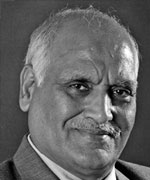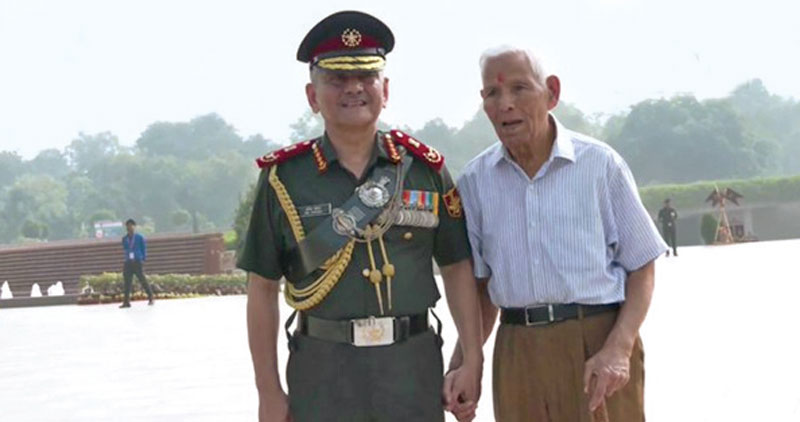General Chauhan has erudition, orientation, exposure to deliver a national war effort
 Maj Gen. Raj Mehta (retd)
Maj Gen. Raj Mehta (retd)
The early morning call on September 30, 2022 came from Baramula, Kashmir. The caller was a local and the subject was Chief of Defence Staff (CDS) General Anil Chauhan. “Jenaab, jo insaan apne buzurg walid ki beinteha izzat karta hai woh Inshaallah fauji zimmewarian muqammal karega. Jab aap unse mukhatib hue toh unhen hamari duayen pahunchayen” (An officer who can care for his aged soldier father can perform any task allotted to him. Do convey our best wishes to him).
The caller was referring to General Chauhan aiding his aged father at the national war memorial at India Gate before assuming office as the new CDS. Though General Chauhan commanded the Baramula-headquartered 19 (Dagger) Division back in 2015-2016, the awaam still cherishes the memories. The residents of the ancient frontier town on the Muzaffarabad-Uri-Baramula-Srinagar highway also remember the charismatic first Indian GOC, Maj Gen. (later Army Chief) K S Thimayya. The General saved Kashmir for India in 1947-1948 along with the fledgling yet brilliantly led Indian Air Force.
He was ably supported by Air Commodore ‘Baba’ Mehar Singh and Air Vice Marshal (later IAF Chief) Subroto Mukherjee. The Indian Air Force at that time had only three DC-3 Dakotas so it pressed into service 12 war-surplus DC-3s with India’s private airlines. Sqn Ldr K L Bhatia and Lt Col Dewan Ranjit Rai, the commanding officer 1 Sikh, decided to land troops on the dusty, unpaved airstrip in Srinagar on the morning of October 27, 1947. Lt Col Rai wasted no time in rushing to Baramula, halting the Kabaili advance the next evening. But this came at the cost of the lives of Lt Col Rai and 17 soldiers. The delay in the Kabaili advance gave the IAF time to ferry more troops and weapons. The Army-IAF synergy created by the Air HQ and HQ Delhi and East Pakistan Command (today’s Western Command) saved Kashmir for India.
We can sometimes be unreasonably cynical, argumentative, caustic and critical. These characteristics often overshadow family values and human gestures. As a result, the Kashmiri awaam’s reaction to General Chauhan’s gesture may seem inconsequential, especially when the new CDS faces the pressing need to prepare an overarching strategy and implement jointness among the three services. Besides, there are linked issues such as modernisation, Aatmanirbharta (self-sufficiency) and Agniveer.
But such denigration can only be our peril. That’s because the CDS and the service chiefs face daunting challenges. General Chauhan has to hear out equals with a great sense and sensibility, he needs to empathise with genuine concerns and encourage the chiefs to offer integrated solutions. Emotional intelligence (EQ) will demand deleting service-related baggages and angularities. There needs to be a willingness to reach a consensus on utilisation of scarce resources without compromising on the government’s more bang for the buck directive. EQ is also needed because the jointness and integration we seek is between emotive humans and not soulless machines. Apex decisions between top level equals are based on human relations demanding respect, high integrity and professionalism in which EQ/IQ and its wise use matters.
Strategy is described as a theory of victory. The CDS will need to build a consensus on the extent to which such strategies should be about planning, adaptation or both; or whether it’s just about military activity or something far broader. Besides this, the chosen approach must unambiguously answer the fundamental question about what should be done. This is what the Theatre Command formatting and jointness are all about, an unfinished task with some angularities left behind by General Chauhan’s predecessor, General Bipin Rawat (retd), who was also a regimental officer, a Dagger Division GOC and a soulmate. We must not forget that each person is different but I see General Chauhan as creatively different.
A few past military examples illustrating personalities and the attributes they displayed in high office illustrate what’s needed. Gen. George C. Marshall of the US Army was reputed to be a top class strategic organiser, planner and executer during World War II. Gifted with well-thought through delegation skills, this erudite General extracted an amazing output from capable subordinates. He carried an aura of quiet authority behind an unflappable temperament. He displayed an infectious integrity, took losses and successes with equanimity and steered the humongous Allied forces to victory.
Then there was the legendary Vietnamese General Nguyen Giap. His stunning military successes against the French at Dein Bein Phu and the Americans in Vietnam are synonymous with the harmony of talent, morality and personality. He was simple, brave, intelligent, humane, friendly, fair and loyal.
One is reminded of the late Army Chief, Gen. B C Joshi, with whom I had worked in the 1970s. An Uttarkhandi Kumaoni like General Chauhan, he was supremely self-confident, insightful, hands-on, professional, scholarly (his doctoral thesis was on Kautilya) and incurably hard working. The suave, earthy and charismatic Joe, as he was popularly known, invariably heard out competent subordinates. Superbly networked, he also had the skill sets to take all along. He mattered and his peers knew he did.
I was well into retirement in 2015 when I unexpectedly received a copy of General Chauhan’s book, Aftermath of a Nuclear Attack, with a cryptic message: “Expecting a review sir.” We had linkages. I had commanded 19 (Dagger) Division years before him. The peer-reviewed book with oversight by reputed nuclear expert, Professor Rajaraman of Jawaharlal Nehru University, made me sit up. I found it professional, fact-driven and objective. During his Baramula tenure, General Chauhan also updated the history of the Dagger Division while earning accolades for the Division’s operational contribution. As Centre Commandant of the 11 Gurkha Regiment, he wrote the Centre’s history.
His career details don’t bear reiteration, but he had exposure to counter insurgency, counter terrorism and conventional warfare in all ranks, from Major to Army Commander on the line of control and the line of actual control in command and staff assignments. He has served at HQ IMTRAT, Bhutan; as a UN observer in Angola; as a Perspective Planning Director handling nuclear issues; was DG Discipline, Ceremonials and Welfare and DG Military Operations at a militarily sensitive and proactive time. His tenure as a Military Adviser to the National Security Council Secretariat should come in handy as the CDS. A Staff College graduate, he is a Higher Command and National Defence College graduate. General Chauhan thus has the erudition, orientation and exposure to deliver.
But though the CDS may make grand structures, allot theatre related missions and tasks and integrate warfighting, it is worth remembering the Prussian strategist Gen. Helmuth von Moltke the Elder’s pragmatic axiom that ‘No war plan survives contact with the enemy.’ General Chauhan as the CDS knows that joint structures and flexible plans, if woven in with his warfighting doctrine for India’s armed forces, can meet unexpected realities when they occur or are about to occur.

Future war needs to be joint and integrated. No service can or will disagree with this truism. No country in the world, including the US, can afford the prohibitive luxury of single-service warfighting. Fighting together implies that the defence budget gets utilised optimally without costly/wasteful overlaps in weapons, operational logistics, management structures, command, control, communication, surveillance, intelligence and reconnaissance. Service differences are about time, space, employment norms, whether distributed or concentrated, as also about budgeting priorities. General Chauhan’s ability to convert the ‘we’ and ‘they’ into ‘us’ is the main charter of the CDS. He has to orchestrate the nation’s war as a national effort rather than the three services seeking a linear military victory. He also has to oversee self-sufficiency (Aatmanirbharta) and make the new recruitment norms (Agniveer) a success.
The US has had its jointness-promoting Goldwater-Nicholls 1986 Act. Moderately successful, it is being redrawn since 2016 to rule out its many glitches/friction points. Dozens of nations worldwide have had a CDS in place since Italy appointed Gen. Grazzano Badoglio (retd), the world’s first CDS, in May 1925. What is important is that each nation approaches warfighting suitable for its geopolitics, geostrategy, its drivers of national power and military strategy.
We should have had a functional CDS along with a bench-marked warfighting system when we became independent. We delayed it till 1999, when the acceptance of necessity was stated and established. But we have only recently realised that India urgently needs a CDS to underwrite its sovereignty and, when compelled, win military victory and not just win linear campaigns. This will demand from our CDS and his military peers the need to widen their strategic outlook. They need to factor in the role of diplomacy, power-projection, international organisations, self-sufficiency, economics, trade, commerce, transportation, space management, special operations, culture and homeland/internal issues into their overarching operational plans. These aspects will need jointness and integration.
I wish General Chauhan well in his endeavours. He can do it. He must.
(The writer has served as DDG (Military Operations) Army HQ and COS at Srinagar’s HQ 15 Corps/

